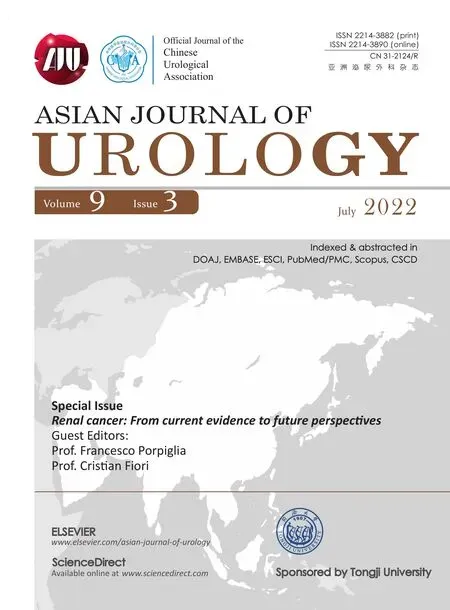Gene expression profiles and treatments for metastatic renal cell carcinoma:What does still need to be defined?
Approximately one third of renal cell carcinoma(RCC)patients have metastasis at the time of diagnosis,while one third of localized patients inevitably develop disease recurrence[1,2].To date,there are four drug combinations with immunotherapies which have been approved by the US Food and Drug Administration as first-line therapy in metastatic RCC(mRCC):pembrolizumab(anti-programmed cell death protein 1[anti-PD-1]antibody)plus axitinib(vascular endothelial growth factor receptor[VEGF-R]tyrosine kinase inhibitor[TKI]),avelumab(anti-PD-L1 antibody)plus axitinib,nivolumab(anti-PD-1 antibody)plus cabozantinib(multi-target TKI),and nivolumab plus ipilimumab(anticytotoxic T lymphocyte antigen 4 antibody),replacing monotherapies with TKIs targeting the VEGF-R pathway[1].Therefore,one of the main unmet needs is how to select the best first-line regimen for treatment-na?¨ve mRCC patients.Heng score has been validated as a useful prognostic score[3]and it has been used to stratify treatment-na?¨ve mRCC patients enrolled in clinical trials,being low-score patients usually treated with anti-angiogenic TKIs and intermediate/high-score ones with combination therapy;however,it could not be useful on its own for choosing between immuno-immuno and immuno-TKI combination therapies.Genetic alterations,i.e.,PBRM1 mutations,have also been interrogated as predictive factors for immunotherapy,with conflicting results[4].
In this scenario,it is crucial to develop biomarkers able to predict response or lack of response to available therapies.
Motzer et al.[5]evaluated gene expression profiles(GEPs)on tumor specimens from patients enrolled in the JAVELIN Renal 101 clinical trial(avelumab+axitinib vs.sunitinib)and correlated them to progression-free survival(PFS)in both arms of treatment.The 26-gene Renal 101 Immuno-signature-comprising regulators of adaptive and innate immune responses,cell trafficking,and inflammation-was able to stratify patients only in the combination arm,with an improvement in PFS in patients who had greater than or equal to the median expression of this signature.In a similar but opposite way,a 26-gene angiogenesis discriminated patients in the sunitinib arm-but not in the combination one-with a prolonged PFS.
GEPs from the IMmotion150 phase 2 trial-atezolizumab(anti-PD-L1 antibody)alone or in combination with bevacizumab(anti-VEGF)versus sunitinib as first-line therapy in mRCC-identified three main signatures:angiogenesis,T-effector,and myeloid signatures[6].Interestingly,sunitinib efficacy was greater in highly angiogenic tumors(high angio-signature),whilst atezolizumab showed lower responses in case of myeloid inflammation(high myeloid signature)even if the addition of bevacizumab in such cases may overcome resistance to immune checkpoint inhibitors.
The GEPs of 469 clear cell RCC patients from The Cancer Genome Atlas have been studied by D’Costa and colleagues[7],who have identified a 66-gene signature that clusters patients into three groups:angiogenesis,T-effector,and mixed signature.Differently from the use of IMmotion150 32-gene signature applied to the same population,this 66-gene signature was able to stratify patients with a better overall survival and disease-free survival for angio-signature compared to the others.
The 66-gene signature was also applied to 316 RCC patients as described in the abstract by Barata and colleagues[8],showing significantly different mutations and immune profiles between angiogenesis and T-effector signatures.In details,biomarkers of potential response to immunotherapy such as PD-L1,tumor mutational burden,and deficient mismatch repair were more frequent in the T-effector signature,even if only the difference of PD-L1 expression was statistically significant.
Sequencings of bulk and individual RNA transcripts are important tools to study not only tumor characteristics but also to inquire tumor microenvironment and to dissect biology of specific cancer types,identifying subgroupswhich may behave differently also in relation to therapies.In mRCC patients,however,the studies so far presented,were not able to validate a specific signature(i.e.,immune signature vs.angiogenic ones)as a predictive biomarker of response to treatments.In fact,even if the T-effector signature predicted high responses in patients who received combination with immunotherapy,these same patients were also treated with TKIs;on the other hand,the angiosignature would not clarify the role of VEGF-R targeting agents since patients were treated with TKIs in both of the arms of the aforementioned trials.
Therefore,to clinically validate and explore the prognostication of GEPs in order to identify specific subset of patients who benefit from a specific therapy,clinical trials should be designed using GEPs as stratification factors.In this way,they would be able to assess the specific impact of those signatures in relation to the treatment received by the patients.
In conclusion,GEPs are a potentially useful tool to predict response to specific therapies and could guide clinicians in choosing among different therapeutic options,but the lack of clinical validations of“real world”patients’stratification based on GEPs data and the lack of GEPs-led clinical trials makes their use difficult at the moment.
Author contributions
Study concept and design:Pasquale Rescigno.
Drafting of manuscript:Emilio F.Giunta.
Critical revision of the manuscript:Roberto Pili.
Conflicts of interest
The authors declare no conflict of interest.
Emilio F.Giunta Pasquale Rescigno*
Interdisciplinary Group for Translational Research and Clinical Trials,Urological Cancers(GIRT-Uro),Candiolo Cancer Institute,FPO-IRCCS,Candiolo,Turin,Italy
Roberto Pili
Division of Hematology and Oncology,Jacobs School of Medicine and Biomedical Sciences,University at Buffalo,Buffalo,NY,USA
*Corresponding author.
E-mail address:pasquale.rescigno@ircc.it(P.Rescigno)
27 January 2022
 Asian Journal of Urology2022年3期
Asian Journal of Urology2022年3期
- Asian Journal of Urology的其它文章
- Burned-out testicular seminoma with retroperitoneal metastasis and contralateral sertoli cell-only syndrome
- Endoscopic management of adolescent closed Cowper’s gland syringocele with holmium:YAG laser
- Transcutaneous dorsal penile nerve stimulation for the treatment of premature ejaculation:A novel technique
- Bilateral calcified Macroplastique? after 12 years
- Culture-positive urinary tract infection following micturating cystourethrogram in children
- A phase II study of neoadjuvant chemotherapy followed by organ preservation in patients with muscle-invasive bladder cancer
